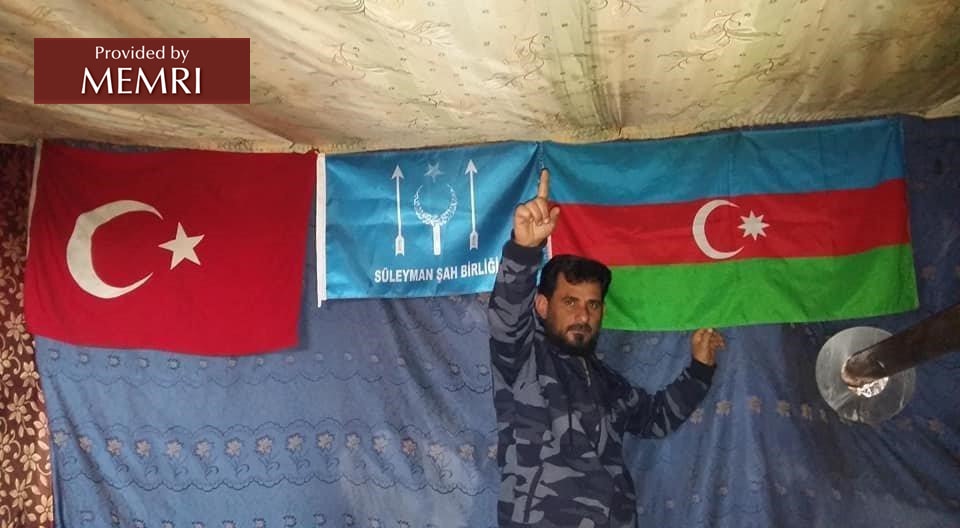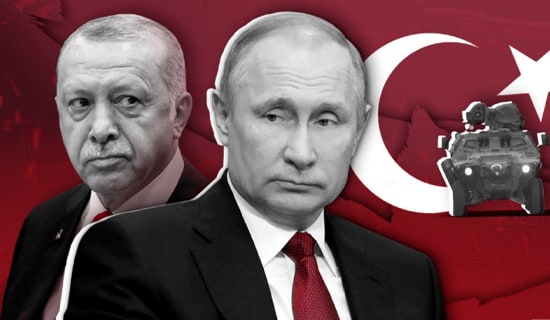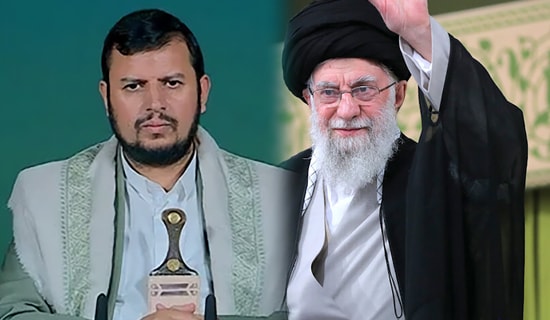On October 16, 2020, Armenian expert Yeghia Tashjian[1] wrote an extensive article, titled "Erdogan’s Enver Pasha Dream: The Revival of the 'Army of Islam'". He argued that Turkish President Recep Tayyip Erdogan dreams of reviving the World War I "Army of Islam" conception of Ottoman Minister of War Enver Pasha.
Tashjian recalls that, in 1997, Erdogan, when he was still Istanbul's mayor recited the poem of Ziya Gokalp, one of the foremost intellectuals of the Turkish nationalist movement: 'The mosques are our barracks, the domes our helmets, the minarets our bayonets and the faithful our soldiers…' Erdogan was briefly imprisoned for this action. According to Tashjian, this poem epitomizes the fundamental ideological narrative of contemporary Turkey. Tashjian believes that Turkey's foreign policy under Erdogan effectively combines a pan-Islamist/neo-Ottoman and pan-Turkic path.
The "Army of Islam" that Erdogan is currently building is comprised mainly of Syrian Turkomans, Syrian Arabs, Turks, and Turkic peoples from North Caucasus, Central Asia and beyond.
Below is Tashjian's article:[2]

Logo of Sultan Murad Division (Source: Armenianweekly.com)
Turkey's Foreign Policy Under Erdogan Follows A Pan-Islamist/Neo-Ottoman And Pan-Turkic Path
"On July 10, 1918, the Ottoman Minister of War, Enver Pasha, ordered the formation of the 'Islamic Army of the Caucasus' in order to repel the Armenian forces in South Caucasus, unite all the Turkic nations in the region under the banner of Islam, and capture the oil fields of Baku. Enver's initiative was quite successful and played a major role in the Caucasus campaign during World War I; however, it had clashed with the German and Russian/Bolshevik interests.
"There were interesting developments in the Caucasus during that time. The Bolsheviks who signed the Treaty of Brest-Litovsk agreed to recognize Georgia's independence under German protectorate and allowed Germany to have 25-percent of Baku's oil. The main aim of the Bolsheviks was to buy time and prevent the Ottomans from capturing Baku by encouraging the historical enemy, the Germans, to capture the railroad and pipeline running from Baku to Batumi. Under German pressure, the Ottomans gave up the idea of capturing the strategic railroad and concentrated their efforts on Baku. On September 15, 1918, the 'Army of Islam' took Baku and committed massacres against the Armenians and communists. However, with the end of the Great War and surrender of the Ottoman Empire, Enver's dream came to an end and his forces withdrew from the region.
"Almost a century later the idea of reviving an 'Islamic army' under Turkish command has still played an important role in the mindset of contemporary AKP leaders. In 1997, Istanbul's Islamist mayor Recep Tayyip Erdogan cited Ziya Gokalp's poem 'The mosques are our barracks, the domes our helmets, the minarets our bayonets and the faithful our soldiers…' which resulted in him being jailed. This poem can summarize the basic ideological narrative of contemporary Turkey. Turkey's foreign policy under Erdogan started to follow a pan-Islamist/ neo-Ottoman and pan-Turkic path, often clashing with its neighbors in the Mediterranean and the Middle East. In order to fulfill his dream, Erdogan needed a loyal army composed of mercenaries. Mercenaries are less costly, and they can be skillful and ready to fight for money. However, Erdogan's 'Army of Islam' also has an ideological backbone since it contains skilled Turkic fighters too.
With The Start Of The Syrian Crisis In 2011, Turkish Nationalism Became A Strong Force In Syrian Turkomans' Ideological Movements
"So who are these mercenaries and the Turkoman fighters eager to die for Erdogan's expansionist policies?
"Syrian Turkomans are of Turkish origin and share a significant part of their culture with Turkey. With the start of the Syrian crisis in 2011, Turkish nationalism began to be a strong force in ideological movements within the community. Turkomans in Syria openly show support for more conservative Turkish parties like MHP and the ruling party, AKP. Neo-Ottomanism and Pan-Turkism is also a common theme among Turkoman brigades in Syria, with several brigades making use of Ottoman flags, Pan-Turkic names and symbols. In order to organize the community, in December 2012 the Syrian Turkmen Assembly, a coalition of Syrian Turkoman political parties and groups, was formed with Turkish backing and support. It was mainly composed of the Syria Turkmen Bloc and the Syrian Democratic Turkmen Movement. The Turkish occupation in Northern Syria seeks to legitimize the military presence of Turkoman fighters, and Ankara considers them the most loyal to its policies and to revive its Ottoman dreams of expansion. Soon the assembly had its military wing called the Syrian Turkmen Brigades headquartered in Istanbul and led by Ahmet Arnavut (also known as Abu Fadil).
"In December 2017, Turkey regrouped all the Syrian Arab and Turkoman military forces and founded the 'Syrian National Army' (SNA). The SNA is a Turkish-backed armed opposition group composed of 80,000 to 100,000 fighters. The bulk of this force consists of the Sultan Murad and Hamza Turkoman divisions/brigades. SNA is concentrated in Turkish-occupied areas in Afrin, Idlib, and Aleppo. The official aim of the structure is to assist the Republic of Turkey in creating a 'safe zone' in Northern Syria, and to establish a 'National Army'. While nominally the SNA has a unitary structure answerable to the 'Syrian Interim Government,' a Turkish-backed political body, the group answers directly to Turkey. Several cases of human rights violations have been reported by the Syrian Observatory for Human Rights (SOHR) where SNA fighters have published pictures of themselves torturing Kurdish war prisoners. The SNA operates as a proxy army for Turkey, engaging in conflicts outside Syria from Libya to the south Caucasus.
"Many active Turkoman militias and divisions are acting under the umbrella of 'Syrian National Army' such as Sultan Murad Division, Mehmed the Conqueror Brigade, Alparslan Special Forces, Syrian Turkmen Front, Sultan Selim Brigade, Anwar al-Haq Battalion, Ashab al-Yamin Brigade, Second Coastal Division, Turkmen Mountain Brigade, Muntasir Billah Brigade, Suleyman-Shah Brigade, Sultan Malik-Shah Brigade, Samarkand Brigade (formerly part of the Hamza Division), Sultan Abdul Hamid Han Brigade. However, I will shed light mainly on Sultan Murad, Sultan Abdul Hamid Han, Suleiman Shah and Hamza divisions due to their effectiveness and popularity.
"The Syrian Turkmen Brigades, also called the United Turkmen Army (Turkish: Birleşik Türkmen Ordusu), represent a wide spectrum of ideologies from Islamism to secular right-wing Turkish nationalism, often in affiliation with the Turkish terrorist 'Grey Wolves' organization. They are composed of dozens of divisions and brigades and trained by the SADAT International Defense Consultancy company (known as Erdogan's Black Water-type private militias). They have recruited not only local Arabs and Turkomans but also Turks and Turkic people from North Caucasus, Central Asia and beyond.

Emrah Çelik, a Turkish volunteer posing with a Central Asian volunteer, both members of Sultan Murad. (Source: Armenianweekly.com)
Divisions And Brigades Fighting For Turkey
"Who are those divisions and brigades?
"The Sultan Murad Division is one of the most famous Turkoman forces formed in early 2013 and mainly operates in the Aleppo and Latakia Governorate, claiming to have around 1,300 fighters as of 2016. This group includes several brigades such as the Mehmed the Conqueror Brigade, Syrian Turkmen Front, Mehmed the Conqueror Brigade, Martyr Zaki Turkmani Brigade, Ashbal Akida Brigade, Ahli Sunnah and Community Brigade, First Regiment, and the Turkmen Martyrs Brigade. On November 1, 2016, a group named the 'Forces of Alp Arslan' was formed in northern Aleppo and joined the Sultan Murad Division; its logo was a modified version of the Grey Wolves. The division also has several Turkish-born fighters such as Zefer Kerkec, who has been seen with several important commanders and Turkish fighters. Also, it has been reported that several fighters from Central Asia and China's Xinjiang Province have joined this division.
"There is also the Hamza Division, formed in 2013, which cooperates with the Turkish Armed Forces. The division followed behind the Turkish infantry and tank divisions and was the first to occupy Syrian Jarablus in 2016. In 2018 it took part in the occupation of Afrin during 'Operation Olive Branch.' In 2019 many of its fighters were sent to Libya to take part in a Turkish-led operation to aid the Tripoli-based Government of National Accord. According to Syrian opposition-based 'Syrian Observatory for Human Rights,' many volunteers from Hamza Division were sent to Azerbaijan to fight the Armenians in Artsakh [also known as Nagorno-Karabakh].
"The Abdul Hamid Han Brigade, part of the Sultan Murad Division, operates in some areas around Latakia, and is also known as the 'Second Coastal Division.' It includes Arabs but is predominantly made up of Turkomans and was active during the invasion of Kessab in 2015. It is named after Ottoman Sultan Abdul Hamid II and led by Syrian Turkoman commander Omer Abdulla. This brigade adopted a more radical Turkish nationalist view than other Syrian Turkoman brigades and divisions. They also make heavy use of symbols related to 'Shahada' (Islamic term of martyrdom). According to social media posts, the brigade consists of around 50 fighters and has light improvised fighting vehicles and multiple rocket launchers.
"There is also the Suleiman Shah Union. Concentrated in the Mount Turkoman area, it is based in Aleppo province and took part in Turkey's Operation Olive Branch (January 2018). Its commander is Halil Abu Nejim.
"Finally, the Second Coastal Division was formed in July 2015 and is led by Turkish-born Alparslan Celik, an ultranationalist Turkish member of the terrorist Grey Wolves organization. In 2014 Celik made his way to Syria and became the commander of the Second Coastal Division. It has been reported that he was the one who killed the Russian pilot Oleg Peshkov who ejected from his jet after being shot down by Turkey in November 2015. He was arrested in Izmir and brought to trial, but all charges were dropped since the court said there was a lack of evidence that he killed the Russian pilot. The division is composed of the following brigades: Brigade of Mountain Turkmen, the Sultan Mehmet the Conqueror Brigade, the Sultan Selim Brigade and the 1071 Raiders Brigade. The group claims it has around two thousand fighters.

Suleiman Shah Union's Commander Halil Abu Nejim with an Azerbaijani, Turkish, and Suleiman Shah Union flags. (Source: Armenianweekly.com)
Erdogan's Battle Over The Caucasus May Change The Balance Of Power In The Region And Beyond
"To conclude, this is not the first time Turkey has recruited mercenaries to fight for its expansionist aims. During the 1990-1994 Artsakh Liberation War, hundreds of Chechens and Afghan Mujahedeen joined the Azerbaijani forces, often with Turkish and Pakistani logistical help. Historically, Europeans gave up mercenaries when they realized that these fighters can switch allegiances, primarily for financial reasons. However, Turkey is one step ahead, as the Turkoman mercenaries support Erdogan's neo-Ottoman and pan-Turkic aspirations based on strong political and ideological convictions. They have occupied territories in northern Syria and resettled there with their families, thus changing the demographic nature of many villages. This suits Turkey's pan-Turkic dreams, to restructure the demography of many bordering towns in Syria and Iraq.
"By sending these mercenaries to Azerbaijan, Turkey may have secret plans to resettle those fighters with their families in bordering or allegedly captured territories. By doing so, Ankara wants to reshape the geopolitical landscape of the Middle East and the Caucasus. These mercenaries will be used as future 'bombs' to be used against Turkey's regional rivals such as Russia and Iran. However, Turkey may use them even as far as in Europe, India and China. One thing is clear, that President Erdogan wants to revive the dream of Enver Pasha and not just in the Caucasus but in the territories stretching from North Africa to Central Asia. Turkey wants to become the absolute ruler of the Muslims and revive the 'Army of Islam' that once Ottoman leaders dreamed of. Unlike 1683, today the 'gates of Vienna' are open in front of President Erdogan; there is no united front to contain his expansionist ambitions as Europeans are fragmented and weak. But President Erdogan, like Enver Pasha, now looks to the East, where oil and his kinships are located again, and the battle over the Caucasus may change the balance of power in the region and beyond.
[1] Yeghia Tashjian is a regional analyst and researcher. He has graduated from the American University of Beirut in Public Policy and International Affairs. He pursued his BA at Haigazian University in Political Science in 2013. He founded the New Eastern Politics forum/blog in 2010. He was a Research Assistant at the Armenian Diaspora Research Center at Haigazian University. Currently, he is the Regional Officer of Women in War, a gender-based think tank. He has participated in international conferences in Frankfurt, Vienna, Uppsala, New Delhi, and Yerevan, and presented various topics from minority rights to regional security issues. His thesis topic was on China’s geopolitical and energy security interests in Iran and the Persian Gulf. He is a contributor to the various local and regional newspapers and presenter of the “Turkey Today” program in Radio Voice of Van.
[2] Armenianweekly.com, October 16, 2020.





